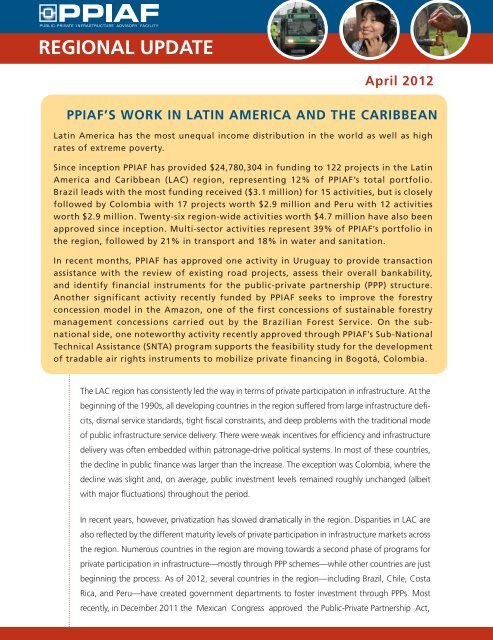PMR cover.psd - ppiaf
PMR cover.psd - ppiaf
PMR cover.psd - ppiaf
You also want an ePaper? Increase the reach of your titles
YUMPU automatically turns print PDFs into web optimized ePapers that Google loves.
PUBLIC-PRIVATE INFRASTRUCTURE ADVISORY FACILITY<br />
REGIONAL UPDATE<br />
April 2012<br />
PPIAF’S WORK IN LATIN AMERICA AND THE CARIBBEAN<br />
Latin America has the most unequal income distribution in the world as well as high<br />
rates of extreme poverty.<br />
Since inception PPIAF has provided $24,780,304 in funding to 122 projects in the Latin<br />
America and Caribbean (LAC) region, representing 12% of PPIAF’s total portfolio.<br />
Brazil leads with the most funding received ($3.1 million) for 15 activities, but is closely<br />
followed by Colombia with 17 projects worth $2.9 million and Peru with 12 activities<br />
worth $2.9 million. Twenty-six region-wide activities worth $4.7 million have also been<br />
approved since inception. Multi-sector activities represent 39% of PPIAF’s portfolio in<br />
the region, followed by 21% in transport and 18% in water and sanitation.<br />
In recent months, PPIAF has approved one activity in Uruguay to provide transaction<br />
assistance with the review of existing road projects, assess their overall bankability,<br />
and identify financial instruments for the public-private partnership (PPP) structure.<br />
Another significant activity recently funded by PPIAF seeks to improve the forestry<br />
concession model in the Amazon, one of the first concessions of sustainable forestry<br />
management concessions carried out by the Brazilian Forest Service. On the subnational<br />
side, one noteworthy activity recently approved through PPIAF’s Sub-National<br />
Technical Assistance (SNTA) program supports the feasibility study for the development<br />
of tradable air rights instruments to mobilize private financing in Bogotá, Colombia.<br />
The LAC region has consistently led the way in terms of private participation in infrastructure. At the<br />
beginning of the 1990s, all developing countries in the region suffered from large infrastructure defi -<br />
cits, dismal service standards, tight fi scal constraints, and deep problems with the traditional mode<br />
of public infrastructure service delivery. There were weak incentives for effi ciency and infrastructure<br />
delivery was often embedded within patronage-drive political systems. In most of these countries,<br />
the decline in public fi nance was larger than the increase. The exception was Colombia, where the<br />
decline was slight and, on average, public investment levels remained roughly unchanged (albeit<br />
with major fl uctuations) throughout the period.<br />
In recent years, however, privatization has slowed dramatically in the region. Disparities in LAC are<br />
also refl ected by the different maturity levels of private participation in infrastructure markets across<br />
the region. Numerous countries in the region are moving towards a second phase of programs for<br />
private participation in infrastructure—mostly through PPP schemes—while other countries are just<br />
beginning the process. As of 2012, several countries in the region—including Brazil, Chile, Costa<br />
Rica, and Peru—have created government departments to foster investment through PPPs. Most<br />
recently, in December 2011 the Mexican Congress approved the Public-Private Partnership Act,

















